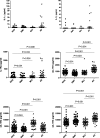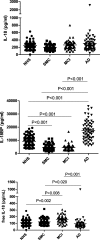Circulating levels of IL-1 family cytokines and receptors in Alzheimer's disease: new markers of disease progression?
- PMID: 30541566
- PMCID: PMC6292179
- DOI: 10.1186/s12974-018-1376-1
Circulating levels of IL-1 family cytokines and receptors in Alzheimer's disease: new markers of disease progression?
Abstract
Background: Although the mechanisms underlying AD neurodegeneration are not fully understood, it is now recognised that inflammation could play a crucial role in the initiation and progression of AD neurodegeneration. A neuro-inflammatory network, based on the anomalous activation of microglial cells, includes the production of a number of inflammatory cytokines both locally and systemically. These may serve as diagnostic markers or therapeutic targets for AD neurodegeneration.
Methods: We have measured the levels of the inflammation-related cytokines and receptors of the IL-1 family in serum of subjects with AD, compared to mild cognitive impairment (MCI), subjective memory complaints (SMC), and normal healthy subjects (NHS). Using a custom-made multiplex ELISA array, we examined ten factors of the IL-1 family, the inflammation-related cytokines IL-1α, IL-1β, IL-18, and IL-33, the natural inhibitors IL-1Ra and IL-18BP, and the soluble receptors sIL-1R1, sIL-1R2, sIL-1R3, and sIL-1R4.
Results: The inflammatory cytokines IL-1α and IL-1β, their antagonist IL-1Ra, and their soluble receptor sIL-1R1 were increased in AD. The decoy IL-1 receptor sIL-1R2 was only increased in MCI. IL-33 and its soluble receptor sIL-1R4 were also significantly higher in AD. The soluble form of the accessory receptor for both IL-1 and IL-33 receptor complexes, sIL-1R3, was increased in SMC and even more in AD. Total IL-18 levels were unchanged, whereas the inhibitor IL-18BP was significantly reduced in MCI and SMC, and highly increased in AD. The levels of free IL-18 were significantly higher in MCI.
Conclusions: AD is characterised by a significant alteration in the circulating levels of the cytokines and receptors of the IL-1 family. The elevation of sIL-1R4 in AD is in agreement with findings in other diseases and can be considered a marker of ongoing inflammation. Increased levels of IL-1Ra, sIL-1R1, sIL-1R4, and IL-18BP distinguished AD from MCI and SMC, and from other inflammatory diseases. Importantly, sIL-1R1, sIL-1R3, sIL-1R4, and IL-18BP negatively correlated with cognitive impairment. A significant elevation of circulating sIL-1R2 and free IL-18, not present in SMC, is characteristic of MCI and disappears in AD, making them additional interesting markers for evaluating progression from MCI to AD.
Keywords: Alzheimer’s disease; Cytokines; IL-1 family; Inflammation; Mild cognitive impairment; Receptors; Subjective memory complaints.
Conflict of interest statement
Ethics approval and consent to participate
This study was conducted in accordance with ethical principles stated in the Declaration of Helsinki, following approved national and international guidelines for human research. The study was reviewed and approved by the Ethics Committee of University of Molise (reference number 26119_II/1–22/10/2009). All participants or their caregivers signed a written informed consent.
Consent for publication
Not applicable.
Competing interests
The authors declare that they have no competing interests.
Publisher’s Note
Springer Nature remains neutral with regard to jurisdictional claims in published maps and institutional affiliations.
Figures



Similar articles
-
IL-1 family cytokines and soluble receptors in systemic lupus erythematosus.Arthritis Res Ther. 2018 Feb 8;20(1):27. doi: 10.1186/s13075-018-1525-z. Arthritis Res Ther. 2018. PMID: 29422069 Free PMC article.
-
IL-1 family cytokines and receptors in IgG4-related disease.Cytokine. 2018 Feb;102:145-148. doi: 10.1016/j.cyto.2017.08.001. Epub 2017 Aug 18. Cytokine. 2018. PMID: 28823915
-
Cytokines and soluble receptors of the interleukin-1 family in Schnitzler syndrome.Scand J Rheumatol. 2019 May;48(3):235-238. doi: 10.1080/03009742.2018.1550210. Epub 2019 Jan 22. Scand J Rheumatol. 2019. PMID: 30668200
-
The family of the interleukin-1 receptors.Immunol Rev. 2018 Jan;281(1):197-232. doi: 10.1111/imr.12606. Immunol Rev. 2018. PMID: 29248002 Review.
-
Peripheral inflammatory biomarkers in Alzheimer's disease and mild cognitive impairment: a systematic review and meta-analysis.Psychogeriatrics. 2019 Jul;19(4):300-309. doi: 10.1111/psyg.12403. Epub 2019 Feb 20. Psychogeriatrics. 2019. PMID: 30790387
Cited by
-
Gene- and Gender-Related Decrease in Serum BDNF Levels in Alzheimer's Disease.Int J Mol Sci. 2022 Nov 23;23(23):14599. doi: 10.3390/ijms232314599. Int J Mol Sci. 2022. PMID: 36498925 Free PMC article.
-
The emerging role of IL-38 in diseases: A comprehensive review.Immun Inflamm Dis. 2023 Aug;11(8):e991. doi: 10.1002/iid3.991. Immun Inflamm Dis. 2023. PMID: 37647430 Free PMC article. Review.
-
Integrated analyses of brain and platelet omics reveal their common altered and driven molecules in Alzheimer's disease.MedComm (2020). 2022 Oct 13;3(4):e180. doi: 10.1002/mco2.180. eCollection 2022 Dec. MedComm (2020). 2022. PMID: 36254251 Free PMC article.
-
Neurobiological Highlights of Cognitive Impairment in Psychiatric Disorders.Int J Mol Sci. 2022 Jan 22;23(3):1217. doi: 10.3390/ijms23031217. Int J Mol Sci. 2022. PMID: 35163141 Free PMC article. Review.
-
Peripheral sTREM2-Related Inflammatory Activity Alterations in Early-Stage Alzheimer's Disease.J Immunol. 2022 May 15;208(10):2283-2299. doi: 10.4049/jimmunol.2100771. Epub 2022 May 6. J Immunol. 2022. PMID: 35523454 Free PMC article.
References
-
- Alzheimer’s Disease International. World Alzheimer Report 2015: The global impact of dementia: an analysis of prevalence, incidence, costs and trends. London: Alzheimer’s Disease International (ADI); 2015. Available at: http://alz.co.uk/research/world-report. Accessed 9 Dec 2018.
MeSH terms
Substances
Grants and funding
LinkOut - more resources
Full Text Sources
Medical
Miscellaneous

